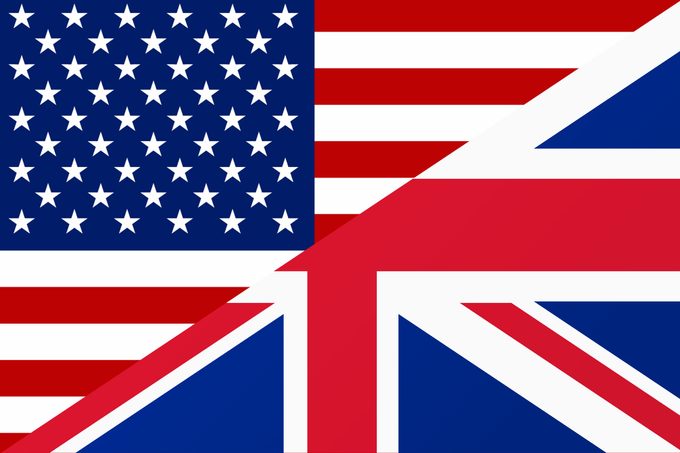To the rest of the world, it's just the "western accent," innit? But where did the American accent come from?

Where Did the American Accent Come From?

For two countries whose histories are so intertwined, the United States and England have some pretty notable distinctions. Think miles vs. kilometers, dollars vs. pounds and driving on opposite sides of the road! But one of the quirkiest contrasts? The way they each speak. Both Americans and Brits call it English, yet the accents couldn’t be more different. So how did that happen—and exactly where did the American accent come from?
Before we dive into why American and British accents sound so different, it would help to know what an accent actually is—and how the American one came to be. So buckle up, because on the sked-jool (or should we say shed-yool?) today is a quick history lesson that’ll explain exactly where the American accent came from.
Get Reader’s Digest’s Read Up newsletter for more knowledge, tech, travel, cleaning, humor and fun facts all week long.
What is an accent?
First, let’s go over a lesson in Linguistics 101 to understand the difference between an accent and a dialect. According to Merriam-Webster, an accent is “an effort in speech to stress one syllable over adjacent syllables.” So an accent is a varied pronunciation of a language, and also the reason an American may be reading this article for LEE-zher while a Brit may claim it to be a LEH-zher activity.
The difference between an accent and a dialect
A dialect, on the other hand, is a regional variety of a language that includes different vocabulary and grammar, in addition to pronunciation. Two important factors in the formation of a dialect are isolation from the source of the original language and exposure to other languages.
So while “football” for an American means the sport with touchdowns, helmets and lots of tackling, a Brit would imagine the game that includes round balls, goals and players mostly using their feet (aka the game Americans call soccer). That’s an example of a dialect difference between the two nations.
What we’re tackling is the reason why the American accent is so different from the British accent, even for words we spell the same and give the same meaning to (think garage, vitamin and basil). Read on to understand the real genesis of the two accents.
How did the American accent develop?
The “American English” we know and use today in an American accent first started out as an “England English” accent. The American accent’s origin—according to a linguist at the Smithsonian—can be traced back to Americans who began putting their own spin on English pronunciations just one generation after the colonists started arriving in the New World. And here’s what gave birth to these pronunciation variations:
- Isolation from the “England English” accent: An entire ocean away from their former homeland, the speakers of American English became increasingly isolated from hearing the “England English” accent.
- Influence of other languages: They also came in more contact with foreign languages—those of the Native Americans and other settlers from Sweden, Spain, France and the Netherlands.
Both factors eventually led to changes in Americans’ vocabulary and grammar, creating a new English dialect. (However, some iconic British slang had such a strong footing that it not only managed to stay with the Americans but is still used today!)
What’s the difference between the British accent vs. the American accent?
An important reason American English and British English sound different is rhotacism, the change of a particular sound in a language. In this case, that sound is “r.” The standard American accent—what Americans think of as having no accent—is rhotic, meaning that speakers pronounce their “r’s.” Received Pronunciation (aka typical British accents) is non-rhotic, so words like “card” are pronounced like “cahd.”
Another key difference between the American and British accents is the flat “a” vs. the broad “a” pronunciation (such as in words like “dance” and “bath”).
When exactly did Americans lose the British accent?
While it may be difficult to pin down an exact date or year when these linguistic changes took place, history does give us a tentative time period (and reason) when the two accents began diversifying.
At first, English speakers in the colonies and England did use a rhotic accent. But after the Revolutionary War, upper-class and upper-middle-class citizens in England began using non-rhotic speech as a way to show their social status. Eventually, this became standard for Received Pronunciation (also sometimes referred to as the Queen’s English or Oxford English) and spread throughout the country—affecting even the most popular British phrases of the time.
Americans kept their rhotic American accent—for the most part. Port cities on the East Coast, especially in New England, had a lot of contact with the R-less Brits. So if you’ve ever been confused about the different American accents—such as when a Boston native talks about pahking thah cah to pahty hahd—you’ve got rhotacism to thank for it.
Why trust us
At Reader’s Digest, we’re committed to producing high-quality content by writers with expertise and experience in their field in consultation with relevant, qualified experts. We rely on reputable primary sources, including government and professional organizations and academic institutions as well as our writers’ personal experiences where appropriate. We verify all facts and data, back them with credible sourcing and revisit them over time to ensure they remain accurate and up to date. Read more about our team, our contributors and our editorial policies.
Sources:
- Merriam-Webster: “Accent”
- Smithsonian: “When Did Americans Lose Their British Accents And More Questions From Our Readers”
- Britannica: “Received Pronunciation: British standard speech”























